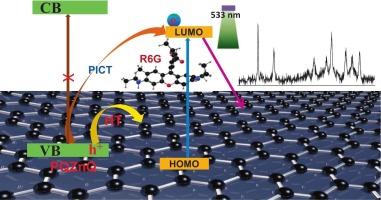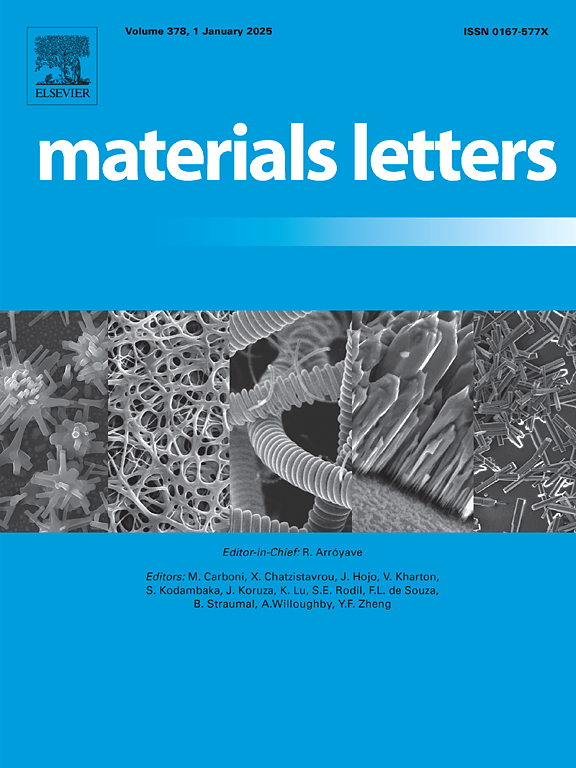Surface-enhanced Raman scattering in graphene oxide improved by grafting organic semiconductor
IF 2.7
4区 材料科学
Q3 MATERIALS SCIENCE, MULTIDISCIPLINARY
引用次数: 0
Abstract
As an excellent candidate for surface-enhanced Raman scattering (SERS) substrates, graphene oxide (GO) has attracted extensive research interest due to its amphiphilicity, flexibility, and diverse chemical modification capabilities. In this study, polymer chains derived from 8-hydroxyquinoline were grafted onto GO (denoted as GO-PQ) via free radical polymerization chain transfer reactions, followed by chelation with zinc acetate 8-hydroxyquinolate to form a GO-PQZnQ composite. This functionalization significantly induces surface wrinkling in GO, enhances the adsorption of probe molecules, and improves light scattering. Efficient charge transfer from both rhodamine 6G (R6G) and zinc 8-hydroxyquinolate to GO leads to emission quenching and reduces background signals. The Raman signal intensity of R6G on the GO-PQZnQ substrate is enhanced nearly sevenfold compared to that on unmodified GO. The grafted PQZnQ complex promotes charge transfer, which contributes to the observed SERS enhancement.

接枝有机半导体改善氧化石墨烯表面增强拉曼散射
作为表面增强拉曼散射(SERS)衬底的优秀候选材料,氧化石墨烯(GO)由于其两亲性、柔韧性和多种化学修饰能力而引起了广泛的研究兴趣。本研究将8-羟基喹啉衍生的聚合物链通过自由基聚合链转移反应接枝到氧化石墨烯(记为GO- pq)上,然后与醋酸锌8-羟基喹啉螯合形成GO- pqznq复合物。这种功能化显著诱导氧化石墨烯的表面起皱,增强探针分子的吸附,并改善光散射。从罗丹明6G (R6G)和8-羟基喹啉锌到氧化石墨烯的有效电荷转移导致发射猝灭并减少背景信号。R6G在GO- pqznq衬底上的拉曼信号强度比未修饰的氧化石墨烯增强了近7倍。接枝的PQZnQ配合物促进电荷转移,这有助于观察到的SERS增强。
本文章由计算机程序翻译,如有差异,请以英文原文为准。
求助全文
约1分钟内获得全文
求助全文
来源期刊

Materials Letters
工程技术-材料科学:综合
CiteScore
5.60
自引率
3.30%
发文量
1948
审稿时长
50 days
期刊介绍:
Materials Letters has an open access mirror journal Materials Letters: X, sharing the same aims and scope, editorial team, submission system and rigorous peer review.
Materials Letters is dedicated to publishing novel, cutting edge reports of broad interest to the materials community. The journal provides a forum for materials scientists and engineers, physicists, and chemists to rapidly communicate on the most important topics in the field of materials.
Contributions include, but are not limited to, a variety of topics such as:
• Materials - Metals and alloys, amorphous solids, ceramics, composites, polymers, semiconductors
• Applications - Structural, opto-electronic, magnetic, medical, MEMS, sensors, smart
• Characterization - Analytical, microscopy, scanning probes, nanoscopic, optical, electrical, magnetic, acoustic, spectroscopic, diffraction
• Novel Materials - Micro and nanostructures (nanowires, nanotubes, nanoparticles), nanocomposites, thin films, superlattices, quantum dots.
• Processing - Crystal growth, thin film processing, sol-gel processing, mechanical processing, assembly, nanocrystalline processing.
• Properties - Mechanical, magnetic, optical, electrical, ferroelectric, thermal, interfacial, transport, thermodynamic
• Synthesis - Quenching, solid state, solidification, solution synthesis, vapor deposition, high pressure, explosive
 求助内容:
求助内容: 应助结果提醒方式:
应助结果提醒方式:


